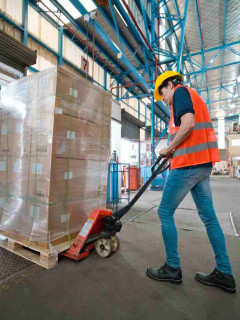In the logistics sector, the risks of developing musculoskeletal disorders, or MSD, are numerous. They account for a large proportion of work-related accidents in the warehouse.
So what can be done to prevent MSDs in the warehouse? Rest assured, there are many ways to avoid them and to make your operators’ work less tiring. Let’s take acloser look at MSD prevention measures.
What is an MSD, or musculoskeletal disorder?
MSDs are pathologies that can affect the joints, tendons or muscles. They can be both physical and mechanical disorders. A musculoskeletal disorder can develop as a result ofintensive use of certain parts of the body over time.Repetitive movements, shocks and bad posture are also common causes .
In the transport and logistics sector, MSDs account for 95% of occupational diseases according to theAssurance Maladie. The most frequent MSDs are :
- carpal tunnel syndrome in the wrist, in 38% of cases
- rotator cuff syndrome in the shoulder, in 30% of cases
- lateral epicondylitis in the elbow, in 22% of cases;
- low back pain (severe pain in the lumbar vertebrae) in 7% of cases.
The lower limbs are less affected by musculoskeletal disorders. Hygroma or bursitis of the knee (inflammation of the bursa located in front of the kneecap) is the best known, and represents only 2% of MSDs.
The keys to preventing MSDs in the warehouse
But what can be done to prevent MSDs in the warehouse? In order toprevent the occurrence of MSDs in operatorsAs an employer, you need to take preventive measures. Identifying risky work situations, correcting them, adapting the work environment, or training operators are all keys to preventing these disorders.
Analyse the risks inherent in your warehouse and map them out
Some areas are more susceptible to incident hazards in a warehouse than others. The first step in preventing MSD hazards in the warehouse is therefore toidentify the workstations that are most affected.
Some order picking phases, such as palletising or packing, are more physically demanding. Observe the MSD risk level of each workstation to obtain an overall ergonomic map. This will enable you to prioritise the different workstations in the warehouse forimprovement.
Provide operators with appropriate handling equipment
In a warehouse, operators may have to handle a number of loads. In addition to the biomechanical risks involved in carrying loads, falling objects can be a further risk .Providing operators with the right handling equipment can limit these risks.
Constant level trucks or variable height, pallet trucks, anti-TMS trolleysor even rolls There are a multitude of solutions tolighten the load for warehouse operators. This handling equipment is also designed to ensure their safety, and thus limit the risk of accidents on a daily basis.
Optimising the packing station for operators
A well-designed packing station is essential to prevent MSDs. This improves the efficiency of the operators, but also the ergonomics of the packing station. It istherefore important todetermine the place of tools according to how often they are used.
The preparer should keep the packaging, labelling machine, adhesive, any cushioning materials and the waste bin within easy reach. Other tools can be used on a daily basis, but less frequently. For example, adhesive refills or pencils should be placed close to the operator, without encroaching on his workstation. Finally, tools used occasionally, such as the cutter, or less frequently used packaging formats, should be kept on the operator’s work area.
Provide standing workstations with the right equipment
Prolonged standing is one of the most physically demanding postures. The result? Operators can end up experiencing muscle and joint pain, particularly in the lower limbs .
A study by the INRS has revealed that almost half of all handlers work in a standing position for more than 20 hours a week. In order to make it less painful for your operators, it is possible to equip the stations with anti-fatigue mats. This equipment allows an even distribution of the weight between the two feet. The musculoskeletal comfort of the operators is thus improved. The sit-stand stool is also a solution to prevent RSI. The objective is tolimit the prolonged standing of your employees.
Acquire packaging machines that limit MSDs
In a warehouse, it is not uncommon for a significant number of pallets and packages to need to be strapped or wrapped. Performed manually, these operations represent a risk of RSI due to the gestures and postures of the operators.
This risk can be prevented bypurchasing suitable packaging machines. Equip your warehouse with automatic wrapping machines for palletising: this will save you time and reduce difficult and repetitive tasks for your employees. To prevent the risk of RSI related to strapping, you should also equip your warehouse with an automatic strapping machine. These machines are ideal for speeding up the packaging line and avoiding strain on the operators’ backs and shoulders.
Implementing medical surveillance
Warehouse jobs are generally physical, and can put the health of operators at risk if the workstations are not adapted. It is essential to set upregular medical visits so that a doctor can check on the health of employees .
According to the Public ServiceAccording to the Public Service website, all employees must undergo an information and prevention visit (IPV) within 3 months oftaking up their post. The maximum period between two medical examinations is 5 years. It may be reduced to three years in certain cases, particularly for employees exposed to occupational risks or with specific working conditions.
Offer anti-MSR training to operators
Limiting the risk of musculoskeletal disorders also involves training in warehouse gestures and good practices. Indeed, since MSDs are often the result of bad posture, intensive stress or poor use of work tools, training is one of the essential keys. You can offer your operators the two training courses provided by RAJA designed to improve working conditions and quality of life, namely
- The Muscle Awakening Training whose objective is to know the disorders and pains related to your sector of activity, and to succeed in setting up an adapted muscular warm-up adapted to the working conditions of your operators.
- The Gestures and Postures training whose content allows you to prevent the risks of occupational diseases and accidentsto train on the principles of ergonomics on the workstations in the warehouse and on the reflexes and gestures to adopt in handling loads.
Would you like to learn more about how to limit the risk of musculoskeletal disorders in your warehouse? Check out our complete guide to detecting and preventing MSDs available on our website. Also check out our article on future technologies to reduce MSDs in warehouses.
















